#tschopp
Explore tagged Tumblr posts
Note
I apologize if this sounds dumb or vague but awhile ago i remember reading something about (it was either brachiosaurus or brontosaurus) not actually existing and actually being a misconstruction? Is this true?
SO
Bone Wars, Marsh vs Cope. Competing to see who could name more dinosaurs. Marsh names a new long neck dino "Apatosaurus"
two years later, he names another one "Brontosaurus"
some decades pass. Scientists look at both specimens. Decide they aren't different enough to be separate genera (genus-es). Lump them into one thing. Since Apatosaurus was named first, that's the name it's given.
Fast forward to 2015. Researcher Tschopp and friends do a very detailed analysis of all the dinosaurs like Apatosaurus, trying to apply consistent standards to dividing up the genera. Determine that Apatosaurus and those species that were once Brontosaurus *are* different enough to split up. Splits them up into two genera once more.
Many sauropod researchers, however, have pointed out flaws in that study - not including particular taxa, weaker points in the analysis, etc. So it's a heavy debate among sauropod researchers whether or not Tschopp et al were correct.
So... maybe. Maybe Brontosaurus is its own thing. Possibly. But also, possibly not.
73 notes
·
View notes
Text

Nils schon wieder. Mit dem Vertigo Trombone Quartet. Vier Posaunen werden von manchen als etwas fordernd wahrgenommen, aber es ist wirklich sehr nett, witzig und clever, und mir können es ja sowieso gar nicht genug sein (idealerweise 76).
#Im Konzert gewesen#Vertigo Trombone Quartet#Bernhard Bamert#Jan Schreiner#Andreas Tschopp#Nils Wogram#Jazz
0 notes
Text
THE UNIQUE ROLE OF A CONSCIOUSNESS BOOSTER COMPARED TO A CONSULTANT

This is where the role of a consciousness coach becomes crucial. Unlike teachers who impart knowledge and skills to navigate the external world, a consciousness coach aids in an internal journey. Their purpose is to guide us back to our innate essence, to the unblemished, joyous beings we were before life’s complexities took over. This process often involves shedding layers of external influence and societal expectations, a journey back to our core.
Bill Withers’ life story serves as a reminder of the importance of staying true to oneself. His decision to leave the music industry, despite its fame and allure, and his contentment in later life, reflects the peace that comes from such authenticity.
In essence, while teachers play a crucial role in our development, guiding us to adapt and grow in a changing world, consciousness coaches help us rediscover and embrace our original selves. They remind us that, amidst life’s constant adjustments, our true essence remains a beacon of joy, peace, and authenticity.
Read More: https://www.marcantoinetschopp.com/the-unique-role-of-a-consciousness-booster-compared-to-a-consultant/
0 notes
Text

A new diplodocine sauropod from the Morrison Formation, Wyoming, USA
Tom T.P. van der Linden, Emanuel Tschopp, Roland B. Sookias, Jonathan J.W. Wallaard, Femke M. Holwerda, and Anne S. Schulp
ABSTRACT
The Morrison Formation of the western United States is well-known for its high diversity of sauropod dinosaurs. The Howe-Stephens Quarry in northern Wyoming is one of several quarries which has yielded several associated to completely articulated dinosaur specimens, among which a semi-articulated diplodocid specimen, MAB011899, which was excavated in 1993. This diplodocid specimen is represented by posterior cervical, dorsal, sacral, and anterior caudal vertebrae, multiple thoracic ribs, two chevrons, a left coracoid, a left ilium, both pubes and ischia, a left femur, a left tibia, and a left fibula. Through comparative anatomy, we interpret this specimen as a new species of diplodocine sauropod, Ardetosaurus viator gen. et sp. nov. Unambiguous autapomorphies include paired accessory laminae in the spinoprezygapophyseal fossae of posterior cervical and anterior dorsal vertebrae, bifurcating anterior centrodiapophyseal laminae in the anterior dorsal vertebrae, fossae present in the centropost zygapophyseal laminae of the second dorsal vertebra, a low vertebral height/centrum length ratio of the posterior dorsal vertebrae and reduced to absent centroprezygapophyseal laminae in the anterior caudal vertebrae. Local autapomorphic features include single centroprezygapophyseal laminae in the posterior cervical vertebrae and a highly elliptical cross-section of the femoral midshaft. Ardetosaurus viator is the first skeletally mature sauropod specimen described from the Howe-Stephens Quarry. This specimen provides insight into serial variation of vertebral laminae and laminar transitions. Finally, the peculiar morphology of the—often not preserved—first chevron is described in detail, and its possible use in studying sexual dimorphism in sauropods is discussed.
Read the paper:
New diplodocine sauropod (palaeo-electronica.org)
415 notes
·
View notes
Text
Ardetosaurus viator van der Linden et al., 2024 (new genus and species)

(Neck vertebra of Ardetosaurus viator, with reconstructed portions shaded in white, from van der Linden et al., 2024)
Meaning of name: Ardetosaurus = burnt [in Latin] lizard [in Greek]; viator = traveler [in Latin, referring to the original specimen having been transported from the United States to Switzerland, Germany, and the Netherlands]
Age: Late Jurassic (Kimmeridgian), between 149.21–150.44 million years ago
Where found: Morrison Formation, Wyoming, U.S.A.
How much is known: Partial skeleton of one individual including multiple vertebrae, part of the hips, and some limb bones.
Notes: Ardetosaurus was a diplodocid sauropod, making it a close relative of Diplodocus and Apatosaurus. Given that the type specimen preserves a large portion of the spinal column, it provides valuable information on how the anatomy of the vertebrae varied across different parts of the spine in sauropods. It also exhibits features of the vertebrae that distinguish it from all other known diplodocids.
The type specimen of Ardetosaurus was dug up in 1993–1994 and has been nicknamed "Brösmeli" (meaning "crumbly" in Swiss German). In 2003, part of the specimen, including several of its neck vertebrae, were destroyed by a fire at the Dinosaurier Freilichtmuseum in Germany (hence the name Ardetosaurus), in a case of malicious arson. Based on microscopic examination of its bone structure, the type specimen was an adult at the time of its death, probably about 22 years old.

(Schematic skeletal of Ardetosaurus viator by Ole Zant [scale bar = 1 m], with preserved bones in white and bones that were preserved but subsequently lost in light gray, from van der Linden et al., 2024)
Reference: van der Linden, T.T.P., E. Tschopp, R.B. Sookias, J.J.W. Wallaard, F.M. Holwerda, and A.S. Schulp. 2024. A new diplodocine sauropod from the Morrison Formation, Wyoming, USA. Palaeontologia Electronica 27: 50. doi: 10.26879/1380
66 notes
·
View notes
Text
Interesting Papers for Week 7, 2025
Noninvasive modulation of the hippocampal-entorhinal complex during spatial navigation in humans. Beanato, E., Moon, H.-J., Windel, F., Vassiliadis, P., Wessel, M. J., Popa, T., Pauline, M., Neufeld, E., De Falco, E., Gauthier, B., Steiner, M., Blanke, O., & Hummel, F. C. (2024). Science Advances, 10(44).
Parallel maturation of rodent hippocampal memory and CA1 task representations. Bevandić, J., Stella, F., & Ólafsdóttir, H. F. (2024). Current Biology, 34(21), 5062-5072.e5.
Brain and eye movement dynamics track the transition from learning to memory-guided action. Büchel, P. K., Klingspohr, J., Kehl, M. S., & Staresina, B. P. (2024). Current Biology, 34(21), 5054-5061.e4.
Sensory representations in primary visual cortex are not sufficient for subjective imagery. Cabbai, G., Racey, C., Simner, J., Dance, C., Ward, J., & Forster, S. (2024). Current Biology, 34(21), 5073-5082.e5.
Dopamine and Norepinephrine Differentially Mediate the Exploration-Exploitation Tradeoff. Chen, C. S., Mueller, D., Knep, E., Ebitz, R. B., & Grissom, N. M. (2024). Journal of Neuroscience, 44(44), e1194232024.
Structural influences on synaptic plasticity: The role of presynaptic connectivity in the emergence of E/I co-tuning. Giannakakis, E., Vinogradov, O., Buendía, V., & Levina, A. (2024). PLOS Computational Biology, 20(10), e1012510.
Acoustic cognitive map–based navigation in echolocating bats. Goldshtein, A., Chen, X., Amichai, E., Boonman, A., Harten, L., Yinon, O., Orchan, Y., Nathan, R., Toledo, S., Couzin, I. D., & Yovel, Y. (2024). Science, 386(6721), 561–567.
Illusionism Big and Small: Some Options for Explaining Consciousness. Graziano, M. S. A. (2024). eNeuro, 11(10), ENEURO.0210-24.2024.
Dopamine-mediated interactions between short- and long-term memory dynamics. Huang, C., Luo, J., Woo, S. J., Roitman, L. A., Li, J., Pieribone, V. A., Kannan, M., Vasan, G., & Schnitzer, M. J. (2024). Nature, 634(8036), 1141–1149.
Cortically Disparate Visual Features Evoke Content-Independent Load Signals during Storage in Working Memory. Jones, H. M., Thyer, W. S., Suplica, D., & Awh, E. (2024). Journal of Neuroscience, 44(44), e0448242024.
Signal Detection Theoretic Estimates of the Murine Absolute Visual Threshold Are Independent of Decision Bias. LaMagna, S., Umino, Y., & Solessio, E. (2024). eNeuro, 11(10), ENEURO.0222-24.2024.
Connectome-constrained networks predict neural activity across the fly visual system. Lappalainen, J. K., Tschopp, F. D., Prakhya, S., McGill, M., Nern, A., Shinomiya, K., Takemura, S., Gruntman, E., Macke, J. H., & Turaga, S. C. (2024). Nature, 634(8036), 1132–1140.
Vagus nerve stimulation recruits the central cholinergic system to enhance perceptual learning. Martin, K. A., Papadoyannis, E. S., Schiavo, J. K., Fadaei, S. S., Issa, H. A., Song, S. C., Valencia, S. O., Temiz, N. Z., McGinley, M. J., McCormick, D. A., & Froemke, R. C. (2024). Nature Neuroscience, 27(11), 2152–2166.
Sense of Agency during Encoding Predicts Subjective Reliving. Meyer, N. H., Gauthier, B., Potheegadoo, J., Boscheron, J., Franc, E., Lance, F., & Blanke, O. (2024). eNeuro, 11(10), ENEURO.0256-24.2024.
Learning probability distributions of sensory inputs with Monte Carlo predictive coding. Oliviers, G., Bogacz, R., & Meulemans, A. (2024). PLOS Computational Biology, 20(10), e1012532.
A neural mechanism for optic flow parsing in macaque visual cortex. Peltier, N. E., Anzai, A., Moreno-Bote, R., & DeAngelis, G. C. (2024). Current Biology, 34(21), 4983-4997.e9.
Temporal dynamics of nucleus accumbens neurons in male mice during reward seeking. Schall, T. A., Li, K.-L., Qi, X., Lee, B. T., Wright, W. J., Alpaugh, E. E., Zhao, R. J., Liu, J., Li, Q., Zeng, B., Wang, L., Huang, Y. H., Schlüter, O. M., Nestler, E. J., Nieh, E. H., & Dong, Y. (2024). Nature Communications, 15, 9285.
A hierarchical reinforcement learning model explains individual differences in attentional set shifting. Talwar, A., Cormack, F., Huys, Q. J. M., & Roiser, J. P. (2024). Cognitive, Affective, & Behavioral Neuroscience, 24(6), 1008–1022.
Coding Dynamics of the Striatal Networks During Learning. Villet, M., Reynaud-Bouret, P., Poitreau, J., Baldi, J., Jaffard, S., James, A., Muzy, A., Kartsaki, E., Scarella, G., Sargolini, F., & Bethus, I. (2024). eNeuro, 11(10), ENEURO.0436-23.2024.
Object color knowledge representation occurs in the macaque brain despite the absence of a developed language system. Zhao, M., Xin, Y., Deng, H., Zuo, Z., Wang, X., Bi, Y., & Liu, N. (2024). PLOS Biology, 22(10), e3002863.
#neuroscience#science#research#brain science#scientific publications#cognitive science#neurobiology#cognition#psychophysics#neurons#neural computation#neural networks#computational neuroscience
10 notes
·
View notes
Text
Watched season 1 of T・P Bon. It's very exciting to see a new anime adaptation of a Fujiko F. Fujio series released internationally on Netflix. Based on this anime (as I've yet to read the manga), I wouldn't quite rank T・P Bon in my top 3 Fujiko F. Fujio series, but it's a pretty good watch. I suspect history buffs especially would have a fun time with it.
T・P Bon skews towards an older target demographic and gets much more graphic than Fujio's better known works, but most of the storylines end on an optimistic note.
Yes, there's a dinosaur episode. As with recent Doraemon works, the production team evidently updated the adaptation to incorporate some modern paleontological advances. Most unexpected and memorable to me is that it references Tschopp et al. (2015) on diplodocid taxonomy!
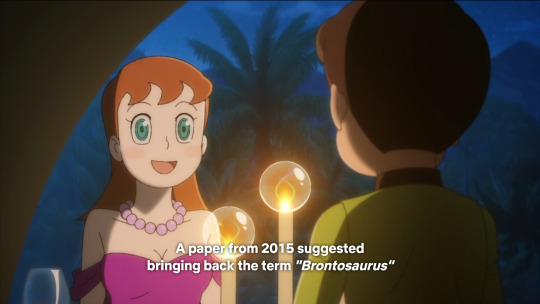
Also fun to see Mesozoic mammals represented by Juramaia, which was named in 2011.
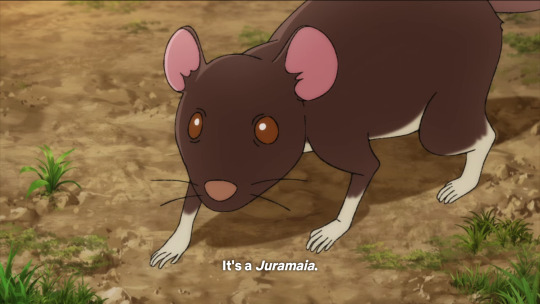
30 notes
·
View notes
Text
FOSSIL FRIDAY: STEGOSAURUS
Stegosaurus, the "roof lizard" is by far the best dinosaur and that is a fact not my heavily biased opinion.

It was discovered by Arthur Lakes in Morrison, Colorado
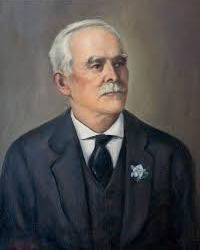
and named by your boy, Marsh.
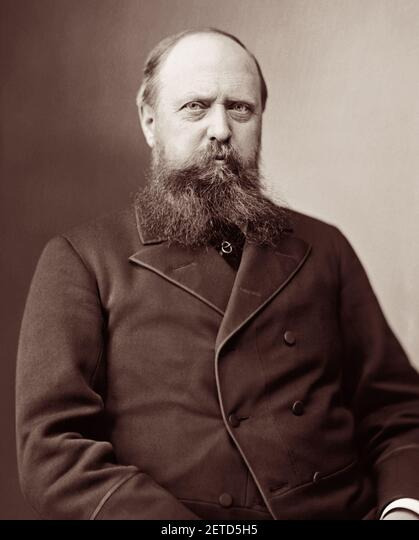
Originally, poor Marsh believed Stegosaurus to be some sort of turtle-like animal which is where the name originated from.
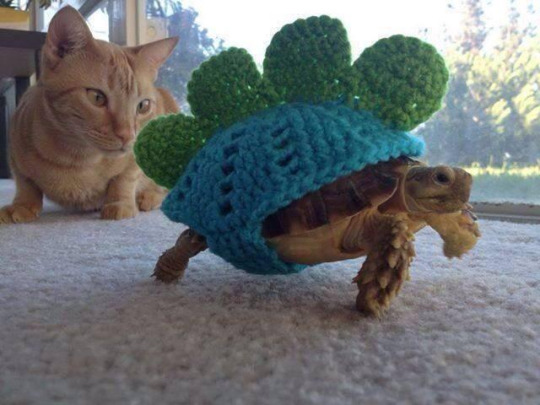
This is one of the first dinosaurs we learn as kids due to the recognizability of the plates and spikes.

(this comic is far too relatable haha)
Stegosaurus was over 20ft long and weighed several tons.
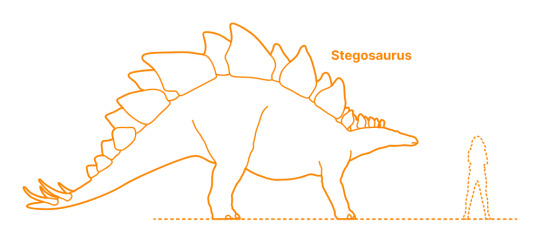
It had a small skull with small, triangular teeth in the back of its mouth for grinding. There were no teeth in the front of the mouth which was probably covered by a keratinous beak.
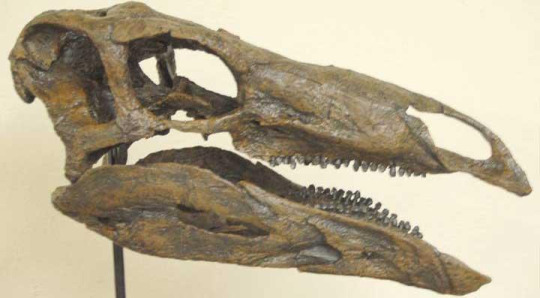
Stegosaurus had around 10 cervical (neck), 17 dorsal (back), 4 sacral (hips), and 46 caudal (tail) vertebrae. The dorsal verts were stretched and the caudal neural spines began to bifurcate (split) halfway down the tail.
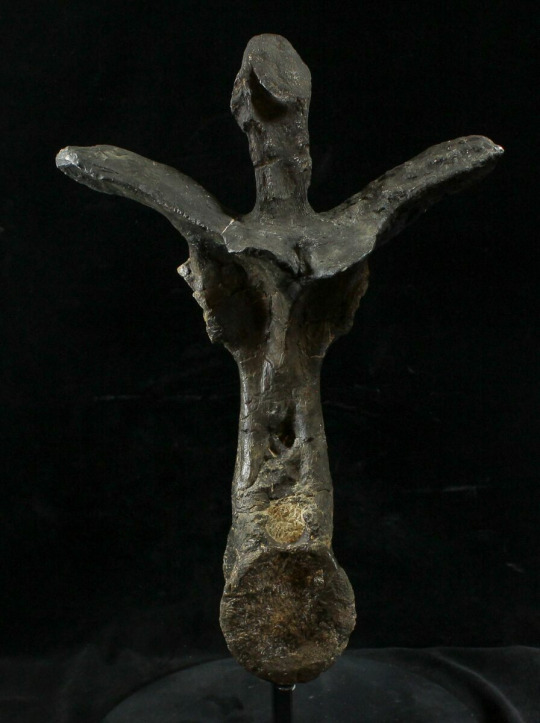
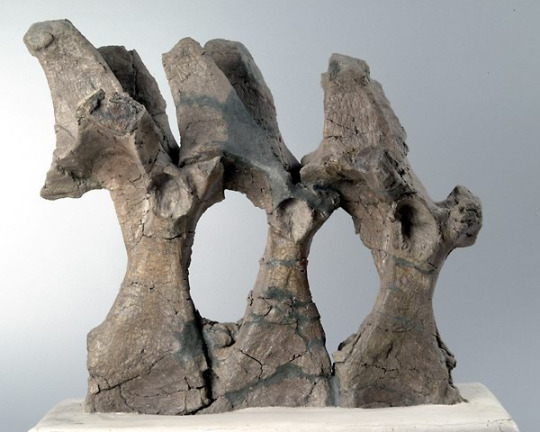
They have three toes on their back feet and five toes on their front feet.
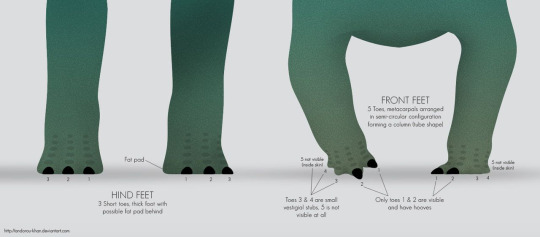
The most recognizable parts are, of course, the plates and spikes. Both of these are highly specialized osteoderms (bony cored scales) similar to modern crocs.
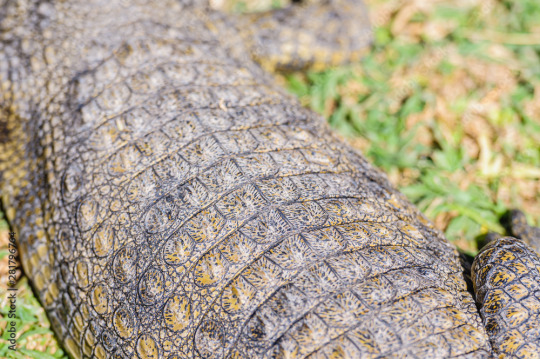
The largest plates were over the hips and were up to 24 in (60cm) wide and tall. The function of the plates has been hotly debated for a very long time. I even wrote a paper about it in one of my paleo classes in college. There are blood vessels running throughout the plates which make them pretty poor for physical defense. However, they would potentially be ideal for flushing blood into and changing the color just like modern lizards.
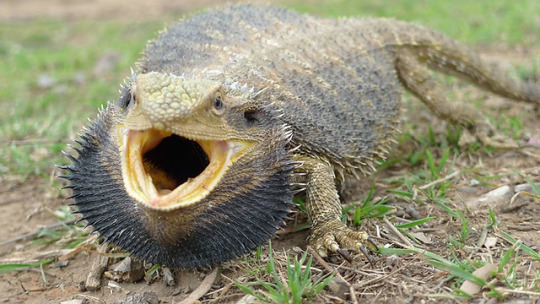
This could be used for aggressive behaviors, male to male warnings or to warn predators to back off. The plates could certainly make a Stegosaurus look larger than it really was. Now, that doesn't mean they were completely without protection. A study done in 2010by Christensen and Tschopp found skin impressions on Hesperosaurus plates and determined it probably had a keratin sheath over the plates making them stronger. Another possible use of the plates was thermoregulation. They could have dumped excess heat the way cattle horns or duck bills do today.
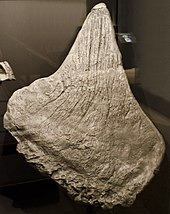

Then, there's the thagomizer. The word actually came from a Far SIde comic and paleontologists liked it so much we just sort of...adopted it.
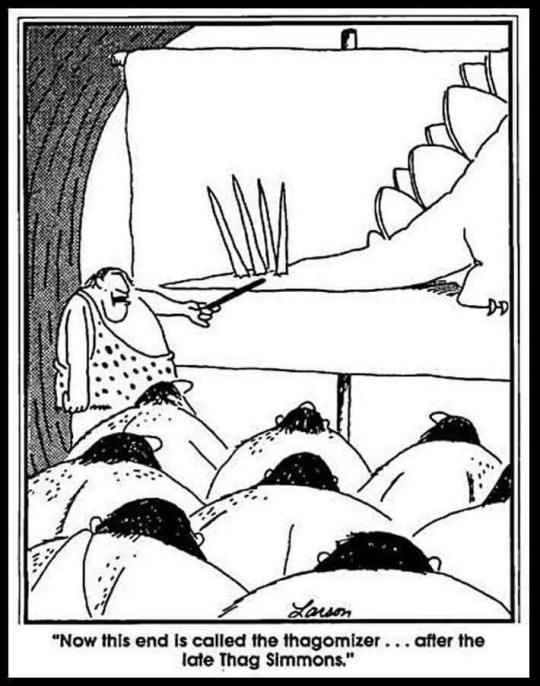
And can you believe there's actually been debate over whether they actually used them?
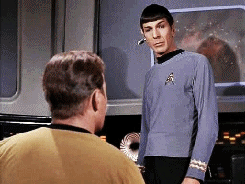
Robert Bakker believed the tail was flexible enough (despite the argument that the plates would make this impossible) to be a weapon due to a lack of ossified tendons seen in other dinosaurs to stiffen the tail. He also said that the front legs were muscular enough to allow it to deftly swivel it's back half threateningly. McWhinney and others did a study that showed high incidence of trauma-related damage to the tail and spikes implying they were, in fact, used as a weapon. Plus, there is an Allosaurus caudal with a puncture that a Stegosaurus spike would fit into snuggly.
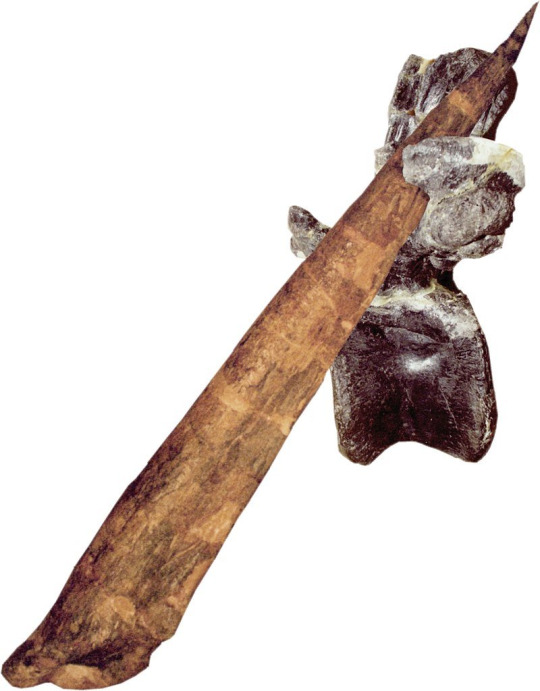
There are two, possibly three species of Stegosaurus: S. ungulatus, S. stenops, and S. sulcatus. The first is probably just a synonym of S. stenops and S. sulcatus is likely an entirely different genus. Only time and more data will tell.

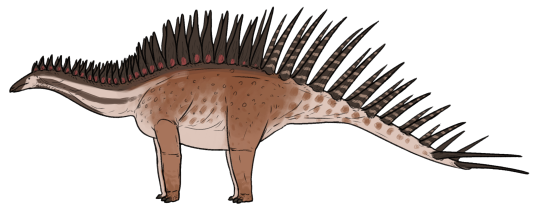
S. sulcatus...which looks nothing like the others.
My absolute favorite thing about Stegosaurus is...well, there two things. First, one specimen was found with throat armor which is just freaking cool.
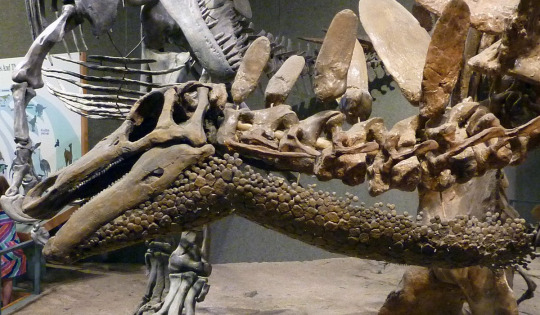
Second, baby stegos are called steglings. Freaking STEGLINGS. How damn cute is that?
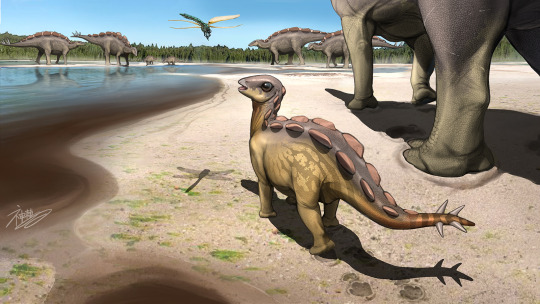
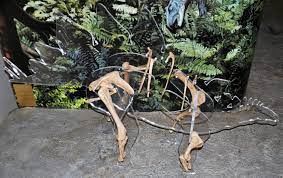
We have found a Stegosaurus tooth at the Evil Tree Bonebed and I really hope we find the animal. A baby would let me die happy. Want to help me find a Stegosaurus? Come join us this summer at CNCC for our summer field program. Check out the link below.
17 notes
·
View notes
Text
YAGP San Francisco Feb 7–9, 2025
Isabella Tjoe: Heaven's Lament (Chehon Wespi-Tschopp)
Isabella Tjoe: Nightfall (Crystal Huang)
Isabella Tjoe: Finale (Megan Ellis Mangat)
#384 Isabella Tjoe: Paquita
#420 Isabella Tjoe: Satanella
Ava Ding: She is Gone to the Sky (Erin Lamoyne)
Ava Ding: Bring Me Back (Megan Ellis Mangat)
#409 Ava Ding: Giselle
2 notes
·
View notes
Text
youtube
Fiona Wu - Red Violin
1st Overall Age 12 Junior Contemporary Solo (Finals) Choreography: Chehon Wespi-Tschopp Yoko's Dance and Performing Arts Academy The Dance Awards Las Vegas 2023
22 notes
·
View notes
Note
Sigh. Just 20 extinct ones then.
so for 20 extinct I'd go with 7 Ornithischians, 4 Sauropodomorphs, 9 Theropods:
Tianyulong
Chungkingosaurus
Polacanthus
Yinlong
Triceratops horridus (sorry this is the only one I'm specifying I just don't have a specific one in mind for the rest where there are options, which to be fair, is few of them)
Eolambia
Olorotitan
Massospondylus
Brontosaurus (if you go with Tschopp et al 2015)
Sauroposeidon
Patagotitan
Daemonosaurus
Limusaurus
Giganotosaurus
Jaculinykus
Mei
Sapeornis
Lithornis
Kumimanu
Zygodactylus
12 notes
·
View notes
Text
Put some jazz juice into your Friday and get a mouth-watering taste of Light Cycle by Skyjack. This unique trans-continental collaboration sees a heavyweight jazz trio from South Africa (Shane Cooper, Kyle Shepherd, & Jonno Sweetman) join forces with two exceptional brass and reed players from Sweden (Andreas Tschopp & Marc Stucki).
4 notes
·
View notes
Text
LEADERSHIP WITH CONSCIOUS | Marc Antoine Tschopp

Understanding our own needs is a monumental task, and deciphering the needs of others is even more complex, especially when they are unconscious of them. The leader faces the arduous task of not only discovering what is best for the team but also encouraging them to communicate their needs openly and honestly.
The essence of leadership transcends the establishment of rules. While laws dictate behavior to ensure order, consciousness serves those seeking to connect with their true selves, imploring natural, ethical, and abundant behavior. This distinction becomes crucial when respecting others, which presents two significant challenges for leaders.
First, imposing one’s perspective, though often filled with good intentions, leads to conflicts within clans, teams, and other groups. Traditional structures within families and businesses may enforce such impositions through hierarchical or role-based expectations. However, such systems can stifle individual growth and contribution.
The second challenge is the inertia of roles and reluctance to question the status quo, leading to abuse of power, especially in times of uncertainty and disruption. To counteract this, the conscious leader adopts a different approach, focusing on the relationship rather than on individual needs.
Read More: https://www.marcantoinetschopp.com/transforming-leadership-with-conscious-connection/
0 notes
Text
youtube
Paul Juon (1872-1940) - Violin Concerto No. 2 in A major, Op. 49 (1912) Dedication: Franz von Vecsey
1. Allegro moderato - attacca (0:00) 2. Elegie (Weiße Nächte). Andantino (11:46) 3. Allegro non troppo (20:56)
Sybille Tschopp, violin and Stadtorchester Winterthur conducted by Nicholas Carthey
4 notes
·
View notes
Text
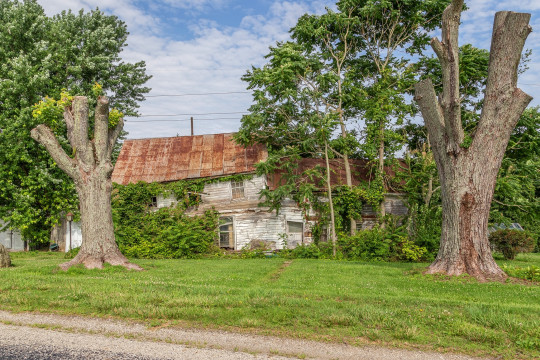
Daniel Tschopp Log House — Pleasant Township, Fairfield County, Ohio by Christopher Riley
Via Flickr:
One of few relatively unaltered early-19th-century log buildings remaining in Fairfield County, and a possible example of a locally rare Germanic three-room plan. The house’s builder, Daniel Tschopp, was a native of Switzerland who moved to Pleasant Township in 1815. Tschopp worked as a millwright, and he presumably donated land for the nearby Tschopp Cemetery and belonged to the adjacent St. Peter’s German Reformed Church. By 1860, just before his death, Tschopp had acquired $6,160 in real estate, and his personal property was valued at $1,653.
2 notes
·
View notes
Text
Frédéric Mairy Les résultats du premier tour de l'élection au Conseil d'État de ce dimanche 23 mars 2025 sont désormais connus. Le candidat sortant Frédéric Mairy et la candidate sortante Florence Nater obtiennent la majorité absolue et sont élu-e-s au 1er tour. Un second tour aura lieu le dimanche 13 avril 2025. Le délai de dépôt des listes des candidates et candidats auprès de la chancellerie d'État est fixé au 25 mars 2025, à midi. Deux élu-e-s à l'issue du premier tour de l'élection au Conseil d'État de ce dimanche 23 mars 2025. Cette première journée électorale aura permis au candidat sortant Frédéric Mairy et à la candidate sortante Florence Nater d'obtenir la majorité absolue fixée à 21'880 suffrages, et ainsi d'être élu-e-s dès le premier tour. Un second tour pour repourvoir les sièges restants aura lieu le dimanche 13 avril 2025. Résultats des élections au Conseil d'État Liste des candidat-e-s et nombre de suffrages : Frédéric Mairy, Gauche Unie, Parti socialiste neuchâtelois (PSN), avec 23'983 suffrages ; Florence Nater, Gauche Unie, Parti socialiste neuchâtelois (PSN), avec 23'405 suffrages ; Laurent Favre, L'Alliance neuchâteloise, Parti Libéral-Radical Neuchâtelois (PLRN), avec 21'327 suffrages ; Céline Vara, Gauche Unie, Les Vert��e·s neuchâtelois·es, avec 20'622 suffrages ; Crystel Graf, L'Alliance neuchâteloise, Parti Libéral-Radical Neuchâtelois (PLRN), avec 20'009 suffrages ; Sarah Blum, Gauche Unie, Parti Ouvrier et Populaire (POP), avec 19'447 suffrages ; Christine Ammann Tschopp, Gauche Unie, Les Vert·e·s neuchâtelois·es, avec 18'816 suffrages ; Quentin Di Meo, L'Alliance neuchâteloise, Parti Libéral-Radical Neuchâtelois (PLRN), avec 17'406 suffrages ; Thierry Brechbühler, L'Alliance neuchâteloise, Union Démocratique du Centre (UDC), avec 16'557 suffrages ; Manon Freitag, L'Alliance neuchâteloise, Le Centre, avec 16'512 suffrages ; Maxime Rognon, Parti vert'libéral (PVL), avec 2'376 suffrages ; Jessica Muriset, Parti vert'libéral (PVL), avec 1'900 suffrages ; Grégoire Cario, Simplement Aider, avec 1'167 suffrages ; Thomas Wroblevski, Modernokratie (Droit de veto populaire), avec 398 suffrages ; Gaëtan Rickli, Modernokratie (Droit de veto populaire), avec 361 suffrages ; Fabio Esposito, Modernokratie (Droit de veto populaire), avec 306 suffrages ; Nolan Bongiovanni, Modernokratie (Droit de veto populaire), avec 295 suffrages ; Yann Bongiovanni, Modernokratie (Droit de veto populaire), avec 290 suffrages ; Jean-Luc Pieren, Parti Fédéraliste Européen (PFE), avec 223 suffrages. Le taux de participation pour l'élection au Conseil d'État s'élève à 31.89%. Second tour fixé au 13 avril 2025 Le second tour de l'élection au Conseil d'État se tiendra le dimanche 13 avril 2025. Seuls les candidats et candidates ayant obtenu au moins 5% des suffrages au premier tour pourront prétendre participer au second tour. Les listes des candidates et candidats au second tour devront être déposées à la chancellerie d'État jusqu'au 25 mars 2025, à midi. Résultats en ligne Vous pouvez retrouver tous les résultats du premier tour de l'élection au Conseil d'État sur www.ne.ch/cantonales2025. Le dépouillement des bulletins pour l'élection au Grand Conseil est, quant à lui, toujours en cours dans trois communes. Les premiers résultats des communes ayant achevé le dépouillement sont également disponibles sur www.ne.ch/cantonales2025.
0 notes